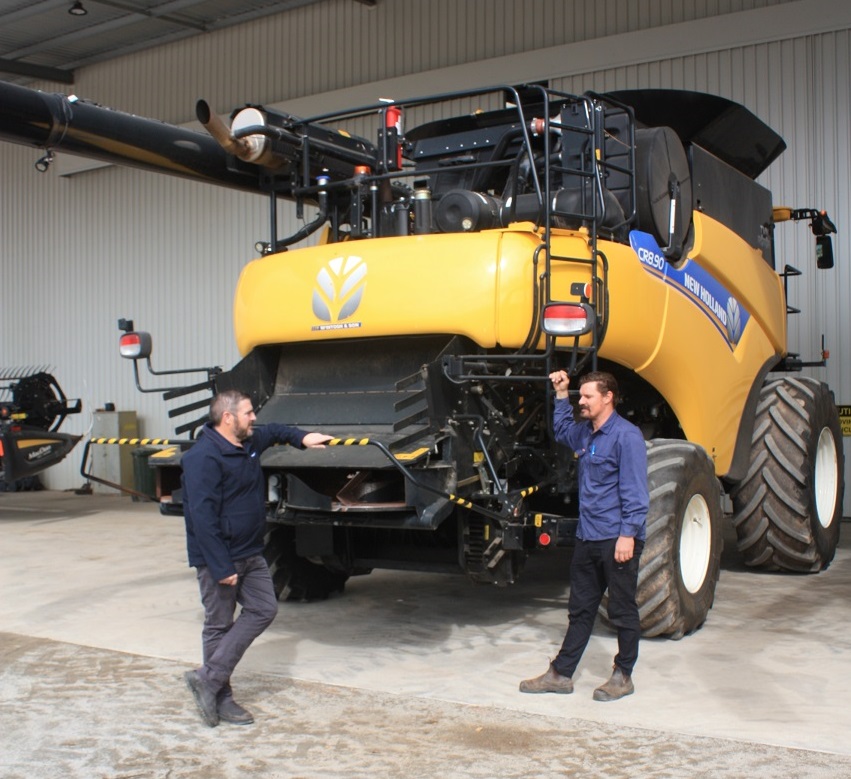

28 August 2020
WEEDS. You’ll never get rid of them. But you can out your boot on them and that’s what farmers have been doing for more than 30 years with Integrated Weed Management (IWM) practices, ranging from spray-topping to chaff carts to windrow burning.

AT A GLANCE:
They are practices familiar to Wongan Hills farmer Stewart Oliver who until last year had a chaff cart in his ‘tool box’ and spent a time-consuming six weeks after harvest burning ‘dump heaps’.
But that’s all changed with the purchase of a Harrington Seed Destructor (iHSD) from his local dealer McIntosh & Son.
And after putting it through its paces over a 3000 hectare program last harvest, he has given it the thumbs-up.
“We had no blocks and the mills are only half worn which is probably predictable given the lighter crops we had.”
It was a measured decision to buy the unit, which was installed to his New Holland CR8.90 header.
“I’ve followed (inventor) Ray Harrington for a number of years and in fact trialled his prototype trailer Seed Destructor,” Mr Oliver said.
“When McIntosh & Son released the mechanically-driven version last year I had a good look at it and liked the design.
“There were no gear boxes and less bearings and it looked like a simple operation.
“So I followed it through and ordered one and I’m happy I did.
“Compared with the chaff cart we could see there wasn’t much seed around and it obviously has reduced the risk of paddock fires by not dumping chaff around the paddocks.
“And it has saved us a lot of time.”
Mr Oliver sees his purchase as helping to accelerate the push to put as much pressure on weed seed banks as possible.
“We’ve been in IWM for more than 25 years with a range of strategies that involve bulky crop rotations, spray-topping, sheep and when we can, double knocks.
“We’ve noticed there’s less weeds around and while we still have some bad paddocks we’re not getting the blow-outs.
“But weeds are still around like we saw after the February rain when we were getting ryegrass germinations, so you’ve just got to be on top of them as much as you can.”
Evaluating the Seed Destructor, Mr Oliver said two factors stood out.
“We didn’t get much dust and we only had to do the usual morning blow down before we got started,” he said. “The dust coming out the back was powder-like, but it gets dragged down to the ground pretty quickly from the chopper’s air blast.
“The class 8 header did use a bit of power, but it wasn’t a big year so we had enough(power).
“Now we’ve got the header in for an engine re-tune to give us an extra 50 horsepower (37 kiloWatts) which takes us up to the equivalent of a class 9 header.”
That will be handy given recent rains have boosted potential crop yields.
“We might have to go a bit slower this year,” Mr Oliver said.
His IWM includes 400 hectares of pasture.
“It’s a ryegrass base so we use the clover for competition then spray top because you just can’t graze it out.
“And with sheep on it, we’re making money out of the paddock.”
Interestingly, his first year of clover establishment starts with an incorporation of lime using a Grizzly offset disc, followed by spreading wheat and barley seed then sowing the clover.
“We get plenty of bulk and that limits the ryegrass,” he said.
Design changes to the mechanically-driven unit include a stone trap; an ability to calibrate a grain loss monitor; a positive material feed into the mills; double flighting on the auger to maintain balance; heavy duty bearings (rated at 4000rpm); elimination of electrics (except for speed and vibration sensor); upgraded pulleys; easier dismantling of the unit with no modifications to the header.
The Seed Destructor has undergone continuous development in recent years by DeBruin Engineering, South Australia, together with national distributor, McIntosh Distribution.
The latest vertical, mechanical-drive system uses the same mill set as the hydraulic version, with independent testing confirming up to 99 per cent-plus kill rates of targeted weed seeds at various harvester speeds.
Harrington Seed Destructors can be fitted to later model John Deere headers (S670, 680, 690 and S770, 780 and 790), Case IH (7230, 7240, 7250, 8230, 8240, 8250, 9230, 9240 and 9250), New Holland (9080, 9070, 8090, 9090, 8.90, 9.90 and 10.90) and CLAAS harvesters (770 and 780 fitted with Mercedes-Benz engines).
Growers interested in further information about the latest system and early orders for next season can contact their local McIntosh & Son dealer.
So far so good,
But perhaps in the future, Mr Oliver might not have to say to his children: “You’ll never get rid of them.”
Hopefully, technology will help to win the battle.